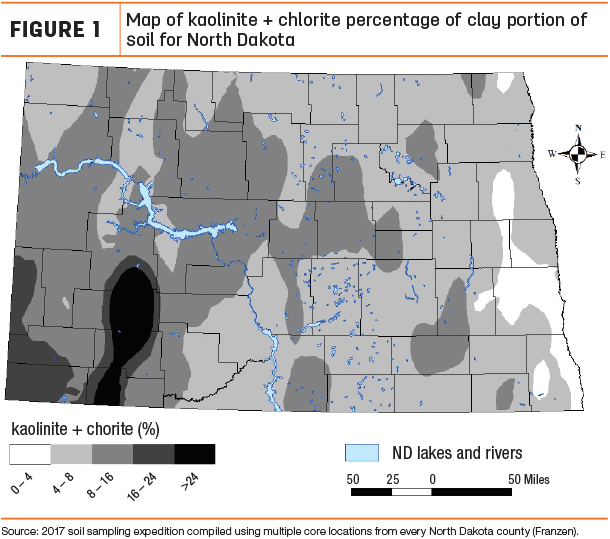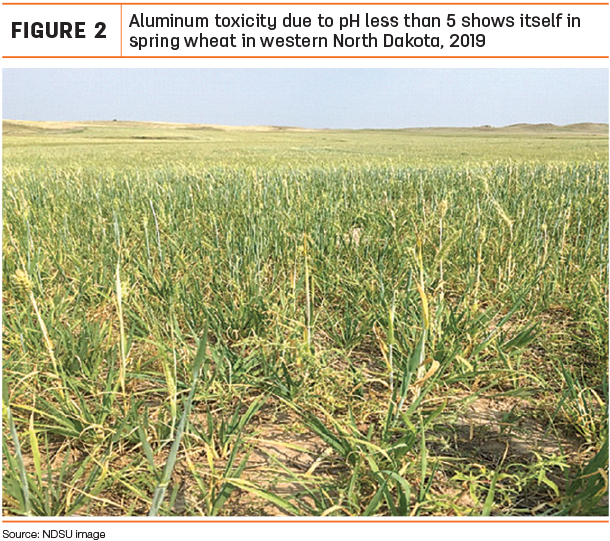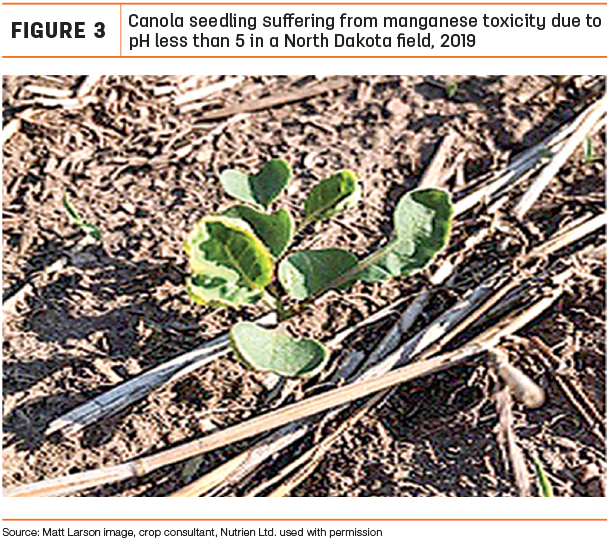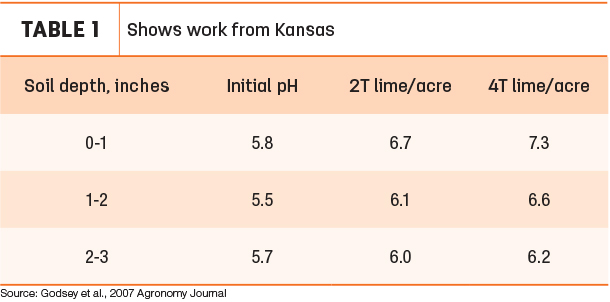About four years ago, extensive areas of very low-pH soils were reported in parts of Montana, followed a couple of years ago by similar problems in North Dakota fields.
Judging from the increase during the 2019 growing season of acid soil problems in western North Dakota, the problem continues to increase.
Decreasing soil pH is the result of near-surface application of ammonium-based fertilizers or manures. In the soil nitrification process, which transforms ammonium to nitrate, hydrogen (H+) ions are released. The measurement of H+ activity is called pH. Over time, soils become more acidic. Ammonium-based fertilizers include urea, anhydrous ammonia, ammonium sulfate, manures, crop residues, cover crop decomposition and green manures of all species.
Because in natural systems the solubility of substances in water is governed by the pH of water in the system, lower pH (which indicates greater H+ activity) results in greater solubility of harmful elements that in pH ranges typical of high crop productivity (pH from 5.2 to 8.4) are nearly insoluble and have no effect on crop growth.
In soils with high pH (greater than 7), which also tend to have carbonates that produce the high pH, the change in pH over time due to ammonium-based fertilizers is minimal due to the ability of soils with carbonates to resist a change in pH and are termed “highly buffered.”
However, many soils west of the Missouri River in North Dakota began with a cropping history about 1880 at pH 7 or below. To further contribute to the current problem, many of these soils contain a high percentage of kaolinitic clay due to their origin in semitropical sediments that are at least 65 million years old.
Kaolinitic clays typically have a cation exchange capacity (CEC) less than 10 milliequivalent (meq) per 100 grams soil compared to illitic clays CEC with 20 to 30 meq per 100 grams soil and smectitic clays with a CEC of 50 to 100 meq per 100 grams soil, which are clays that dominate soils east of the Missouri River. Therefore, the amount of acidity produced through ammonium nitrification in many west river soils produces a greater reduction in pH (greater acidity) than soils with greater illite/smectite content. Figure 1 shows kaolinite/chlorite (a similar CEC clay) in North Dakota.

Most farmers and crop consultants who have found surface acidity have sampled the zero-to-6-inch depth of soil. To do a better characterization of surface acidity development, the sampler must use a hand probe, kick the “duff” out of the way and take a zero-to-2-inch core and a 2-to-6-inch core. These are both important layers of soil to identify. Soil pH less than 5.5 has negative implications for many but not all crops we grow.
However, when soil pH falls below 5, there is much more reason for concern. Legumes find it difficult to support symbiotic N-fixing activity at pH less than 5.5. Aluminum becomes soluble below pH 5 and becomes even more soluble when the pH falls to 4.5. Free aluminum can cause roots to become knobby, and the internal plumbing of the plant root will clog and may result in no crop at all (Figure 2).
 Manganese solubility increases greatly at pH less than 5 and can cause poor growth in many crops including canola (Figure 3).
Manganese solubility increases greatly at pH less than 5 and can cause poor growth in many crops including canola (Figure 3).

The treatment for acid soil is called “liming,” or the application of a carbonate mineral (calcium carbonate for example), or a hydroxide mineral (calcium hydroxide), or an oxide (calcium oxide), which converts the H+ ions to water, effectively neutralizing the acidity, resulting in increased pH and essentially insoluble aluminum, and much lower soluble manganese.
The dilemma for a grower is that historically most lime application in the U.S. is followed by tillage. Long-term no-tillers have wonderfully biologically active soils with great structure, resistance to climate variation and less requirement for fertility. Does lime really have to be incorporated? The answer so far is no. Liming material may be applied to the soil surface, and the effect on the surface inch of the soil is almost immediate.

In Pennsylvania, initial zero-to- 2-inch pH was 4.5. After 3-ton-per-acre lime application, pH increased in the zero-to-2-inch depth to 6.2, with increase in pH even at the 2-to- 4-inch depth. Winter wheat yields increased from 52 bushels per acre to 71 bushels per acre the first year.
In North Dakota, initial studies on remediation of soils through surface application of sugarbeet waste lime from the Sidney, Montana, sugarbeet processing plant have indicated that rapid increase in soil pH and alleviation of aluminum toxicity or manganese toxicity can result from lime application of sufficient quality and rate. Crop productivity is greatly increased following lime application to the surface (Table 2).

Work is continuing in North Dakota to further investigate the effectiveness of surface application in no-till soils, but most of the current studies on the topic support surface lime application as an effective method to combat surface acidity and aluminum toxicity. The greatest challenge will be for fertilizer suppliers, farmers or others to tool up to haul, load and spread the large amounts of liming materials required to address this growing problem on a commercial scale.











